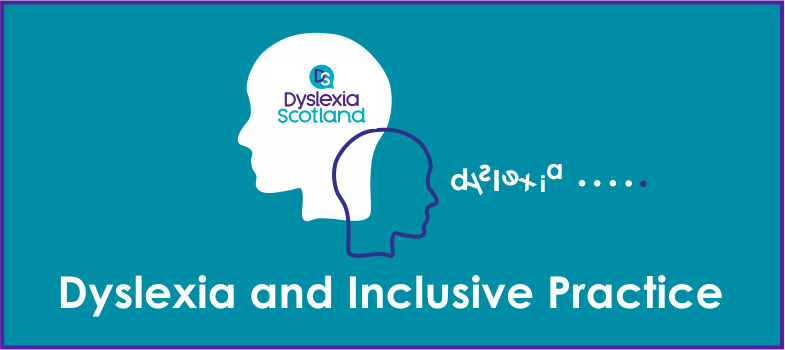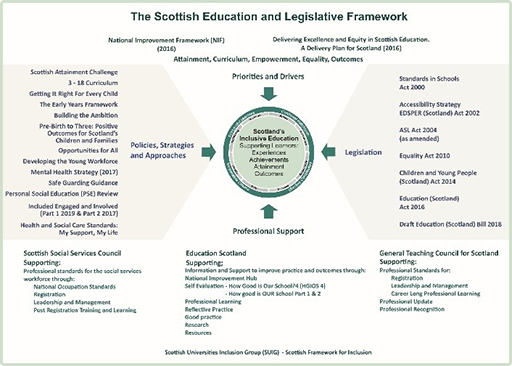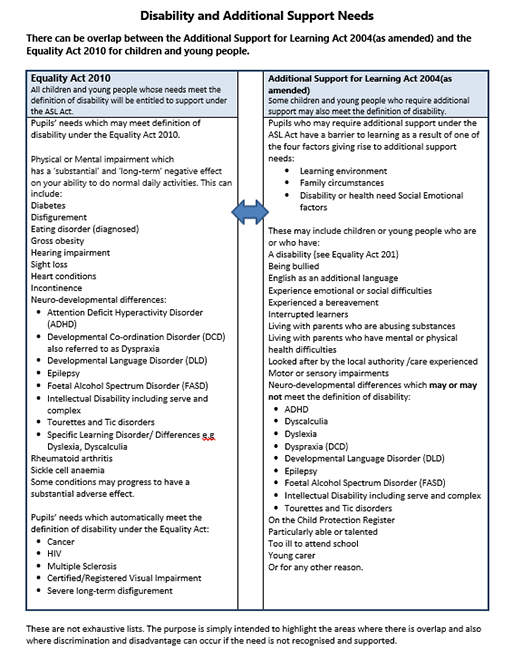1.2. Legislative and policy framework
Module 1: Section 1.1 provided an overview of the Scottish context for education and inclusive practice, highlighting national agendas, legislation and guidance within which local authorities, teachers and other educators work (Refresh your memory of Module 1: Section 1.1 [Tip: hold Ctrl and click a link to open it in a new tab. (Hide tip)] ).
Some of the main Acts that supports inclusion and equality in education are highlighted below and explained in further detail in this section:
- Disability Strategies and Pupils’ Educational Records (2002);
- Additional Support for Learning (Scotland) Act 2004 (as amended 2009);
- Equality Act (2010);
- Children and Young People Act (2014); and
- Education (Scotland) (2016).
Figure 1 provides further details on some specific legislation and policies that promote and support inclusion, equality and diversity within the Scottish context.
The legislation, which places duties on schools and local authorities to support and provide inclusive education for learners in Scotland, can be linked directly to the United Nations Convention on the Rights of the Child (UNCRC). In 2021 Scotland became the first devolved nation within the United Kingdom to enshrine the UNCRC into law. Figure 3 highlights a range of legislation that is in place to support and promote inclusion within Scottish schools and local authorities. Further details of relevant legislation can be found in Section 4 of this module.
Legislative summaries
In Module 1 you should have downloaded the summary of the Scottish educational legislative and policy framework which provides an overview of the most recent legislation and policies.
This section provides information on relevant Acts that underpin the principles of inclusion, wellbeing, equality and equity.
The Standards in Scotland’s Schools Etc. Act 2000
Every child or young person has the right and the entitlement to education, as detailed in this act. They have the right to be educated within mainstream education along with their peers and to use their rights to affect decision-making about them. Local authorities, with their partners, have a duty within the Standards in Scotland’s Schools etc. Act (2000) to ensure that ‘education is directed to the development of personality, talents and mental and physical abilities of the child or young person to their fullest potential.’ This wording deliberately reflects Article 29 1(a) of the UNCRC. This duty applies to all children, regardless of whether they require additional support to reach their full potential. The presumption in favour of providing mainstream education for all children is in place except where education in a school other than a special school would:
- not be suited to the ability or aptitude of the child;
- be incompatible with the provision of efficient education for the children with whom the child would be educated; or
- result in unreasonable public expenditure being incurred which would not ordinarily be incurred.
It will always be necessary to tailor provision to the needs of the individual child and it is recognised that there is a need to make available a range of mainstream and specialist provision, including special schools, to ensure the needs of all pupils and young people are addressed.
The Act also places education authorities under duties to provide education elsewhere than at a school where a pupil is unable to attend school due to ill health, and to make provision where a pupil is excluded from school.
The Education (Additional Support for Learning) (Scotland) Act 2004 (as amended) (the ASL Act)
The ASL Act provides a framework for identifying and addressing the additional support needs of children and young people who face a barrier, or barriers, to learning. Children and young people have additional support needs when they require additional support in order to benefit from school education. Young people are those over school age but who have not yet attained the age of eighteen. The amended Act deems that all looked after children and young people have additional support needs unless the education authority has established through assessment that they do not. The Act also aims to ensure a partnership with parents/carers and collaborative working with professionals from partner services and agencies, to meet the needs of the child or young person. This module supports staff in meeting many of the learning needs of the learners in their school.
The ASL Act places duties on education authorities, requires certain other agencies to provide help where this is requested and provides parents and young people with certain rights.
Education authorities are required to identify the additional support needs of each child or young person for whose school education they are responsible. The Education (Additional Support for Learning) (Scotland) Act 2004 and amendments made in 2009 provide the legal framework for assessment. However, no particular model of assessment or support is prescribed in "the Act".
The 2017 Code of Practice is also very important. This provides guidance on the implementation of the Education (ASL) (Scotland) Act, as amended in 2009. It gives a summary of the Act including clear definitions of which groups of learners are covered by the Act and what constitutes additional support needs. The duties under the terms of the Act on education authorities and other agencies with respect to supporting children‘s and young people‘s learning are set out. Examples of best practice are provided with reference to the Getting it right for every child approach (often referred to as GIRFEC) and Curriculum for Excellence framework. It is designed to help schools, parents and others understand the Act and support its implementation.
The Children and Young People (Scotland) Act (2014)
The Children and Young People (Scotland) Act (2014) places a duty on local authorities and schools to ensure the wellbeing of children and young people is safeguarded, supported and promoted. This has been an important recent change to our range of inclusive education legislation because the experience of the child or young person and the extent to which they feel included impacts on their wellbeing. The voice of the child or young person is essential in understanding their needs and ensuring their wellbeing is safeguarded, supported and promoted. Fostering strong relationships between staff and children and young people is essential to this practice.
The Getting It right for every child approach has been national policy since 2010 and is now defined in statute in the Children and Young People (Scotland) Act (2014). The Act aims to strengthen children’s rights and improve and expand services that support children and families, including looked after children. Its purpose is to ensure an inter-agency approach across education, health and social work to improve outcomes for children and young people.
It helps practitioners focus on what makes a positive difference through developing a shared understanding of wellbeing. It requires public services to work together to design, plan and deliver services for children and young people. This means services taking a collaborative approach to assessing needs and agreeing actions and outcomes to best support the child. Children and families are at the centre of the process. Agencies should work together to support streamlining of planning, assessment and decision-making so that the child gets the right help at the right time.
Most children get all the support and help they need from their parent(s), wider family and local community, in partnership with services like health and education. Where extra support is needed, the Getting it right for every child approach aims to make that support easy to access, with the child at the centre. It is for all children and young people because it is impossible to predict if or when they might need extra support.
Education (Scotland) Act (2016)
The Act introduces measures to improve Scottish education and reduce pupils’ inequality of outcomes. The Act includes provisions for strategic planning in order to consider socio-economic barriers to learning. The rights of children aged 12 and over, with capacity, are extended under the Additional Support for Learning Act. Children who are able to can also exercise their rights, on their own behalf, to affect decision-making about them. Also included within the Act are provisions on widening access to Gaelic medium education and streamlining of the process of making a complaint to Scottish Ministers. The Act also introduces the National Improvement Framework (NIF) and amendments to the Standards in Scotland’s Schools etc. Act 2000, the Education (Additional Support for Learning) (Scotland) Act 2004, the Education (Scotland) Act 1980 and the Welfare Reform Act 2007.
Equality and disability
It is helpful to understand what the term disability means and to appreciate the sensitivity of the term and the range of associated feelings that learners and families may have. For example, some people are very clear that they do not wish to be viewed as disabled, even if they may meet the criteria highlighted below.
A person has a disability for the purposes of the 2010 Equality Act if he or she has a physical or mental impairment and the impairment has a substantial and long-term adverse effect on his or her ability to carry out normal day-to-day activities.
This means that, in general:
- the person must have an impairment that is either physical or mental;
- the impairment must have adverse effects which are substantial;
- the substantial adverse effects must be long-term; and
- the long-term substantial adverse effects must be effects on normal day-to-day activities.
All of the factors above must be considered when determining whether a person is disabled.
Disability models
There are a number of ‘models’ of disability which have been defined over recent years. The two which are most frequently discussed and commonly used are the ‘social’ and the ‘medical’ models of disability; other models have evolved and developed from these two models.
Activity 3
Watch these animations which illustrate the social model of disability.
The Social model of disability and the Scottish context for education support the vision for inclusion in Scotland for all our learners - both disabled and non-disabled. Anticipatory thought is given to how disabled people can participate in activities on an equal footing with non-disabled people. Certain adjustments are made, even where this involves time or money, to ensure that disabled people are not excluded.
Please note that education staff in Scottish educational establishments do not assess and determine if a learner has a disability. This is usually done by health colleagues and should be in partnership with the family and the educational setting.
The duties of the Equality Act 2010 (commenced 1 October 2010) require responsible bodies to actively deal with inequality, and to prevent direct disability discrimination, indirect disability discrimination and discrimination arising from disability and harassment or victimisation of pupils on the basis, or a perceived basis, of protected characteristics, including disability. The provisions include:
- Prospective pupils
- Pupils at the school
- In some limited circumstances, former pupils
In addition, under the Equality Act 2010, responsible bodies have a duty to make reasonable adjustments for disabled pupils and provide auxiliary aids and services. The duty is ‘to take such steps as it is reasonable to have to take to avoid the substantial disadvantage’ to a disabled person caused by a provision, criterion or practice applied by or on behalf of a school or by the absence of an auxiliary aid or service (commenced 1 September 2012).
Further, under the Education (Disability Strategies and Pupils' Educational Records) (Scotland) Act 2002, responsible bodies have duties to develop and publish accessibility strategies to increase pupils’ access to the curriculum, access to the physical environment of schools and to improve communication with pupils with disabilities.
Education authorities and other agencies also have duties under the (Education Additional Support for Learning) (Scotland) Act 2004 (as amended) to identify, provide for and review the additional support needs of their pupils, including those with disabilities. The provision made to support a pupil with an additional support need arising from a disability may include auxiliary aids and services, such as communication tools and support staff.
Education authorities can ask other agencies (including social work services, health boards and Skills Development Scotland) for help in carrying out their duties under the Act. Other agencies must respond to the request within a specific timescale (there are exceptions to these timescales).
Figure 3 highlights the overlaps which can occur between the two Acts concerning disability and additional support needs. Please note that the lists are not exhaustive.
Activity 4 Reflective questions for professional dialogue with colleagues
The following questions can be used when engaging in professional dialogue during professional learning opportunities and discussions with colleagues. The outcomes from these discussions can support planning for professional learning opportunities and improvement plans.
You can collate the responses in your Reflective Log. Select here to download a discussion sheet if required.
- Why does inclusion matter?
- How can the legislation and policies within Scottish education be supported into practice?
Activity 5 Disability quiz
You should now take the Activity 5 quiz.
1.1. The Scottish context for dyslexia and inclusive practice



